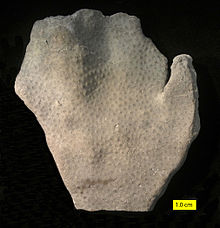Trepostomatida
| Trepostomatida Temporal range:
| |
|---|---|

| |
| Esthoniopora, a trepostome from the Ordovician of Estonia (cross-section). | |
| Scientific classification | |
| Domain: | Eukaryota |
| Kingdom: | Animalia |
| Phylum: | Bryozoa |
| Class: | Stenolaemata |
| Order: | †Trepostomatida Ulrich 1882[1] |
| Families | |
| Synonyms | |
| |

Trepostomatida (the trepostomates) is an extinct order of bryozoans in the class Stenolaemata. Trepostome bryozoans possessed mineralized calcitic skeletons and are frequently fossilized; some of the largest known fossilized bryozoan colonies are branching trepostomes and massive dome-shaped trepostomes. [3] Trepostomes did not have many specialized zooecia beyond ordinary feeding autozooecia. The two main known heteromorphs are exilazooecia and mesozooecia, which had the purpose of maintaining regular spacing between autozooecia. [4]
See also[edit]
References[edit]
- ^ Redescription of type specimens of bryozoan Stigmatella from the Upper Ordovician of the Toronto region, Ontario (1973). By Fritz, Madeleine A., 1896, Royal Ontario Museum
- ^ New Monticuliporidae (Bryozoa, Trepostomata) from the Cystoid Limestone Formation (Upper Ordovician) of the Iberian Chains (NE Spain). Jimenez-Sanchez Andrea, Geodiversitas, 2010, vol. 32, no2, pages 177-199, INIST 22896890
- ^ Ernst, Andrej (2020). "2- Fossil record and evolution of Bryozoa". Phylum Bryozoa. pp. 11–56.
- ^ Ernst, Andrej (2020). "2- Fossil record and evolution of Bryozoa". Phylum Bryozoa. p. 19.
External links[edit]

